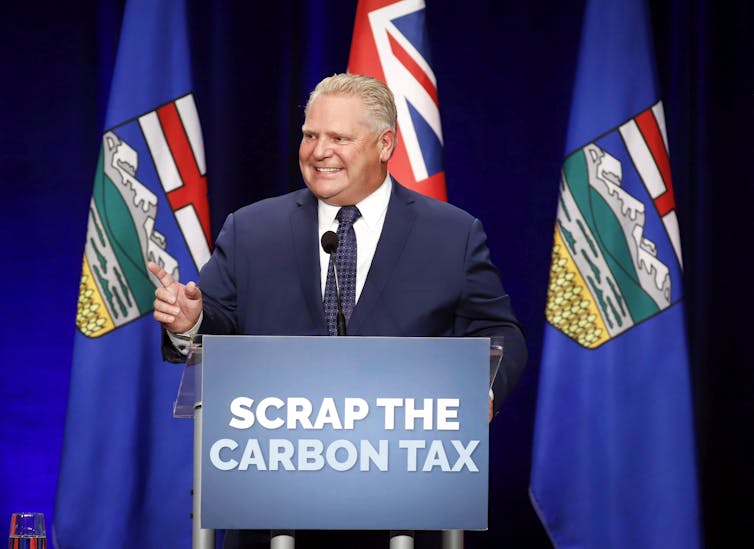It has been a bad few weeks for the federal government’s plans for climate action.
A little more than five years ago, there was a strong federal-provincial consensus around climate action. That consensus included a national carbon pricing system, with the federal government providing a back-stop system where provinces didn’t price carbon themselves.
Canada is now confronted with a very different federal-provincial landscape on climate change. Ottawa’s decision to respond to concerns about the impact of the federal carbon pricing system on heating costs for households relying on fuel oil, primarily in Atlantic Canada, has devolved into a wider debate on the role of carbon pricing in Canadian climate policy.
Alberta, Saskatchewan and Ontario are now demanding the federal carbon price be withdrawn from all types of heating fuels, including fossil natural gas.

Even the government’s supply-and-confidence allies in the NDP voted with the Conservatives in favour of suspending the application of the federal carbon charge to heating fuels altogether.
Adding to the federal government’s difficulties is a report by the Commissioner for the Environment and Sustainable Development that says Canada is unlikely to meet its 2030 emission reduction targets under the Paris climate agreement.
Read more: Introducing The Conversation's new climate series, Getting to Zero
Liberal fragility
It wasn’t supposed to be this way.
Five years ago, B.C., Alberta, Ontario and Québec — representing 80 per cent of Canada’s population — had carbon-pricing systems of their own already. It was expected that the federal government’s own role in carbon pricing would be limited.
Most provinces also had comprehensive climate change strategies, with the overall federal-provincial consensus captured in the December 2016 Pan-Canadian Framework on Clean Growth and Climate Change (the PCF). Only Saskatchewan was a major outlier.
Sadly, that consensus was short-lived. It largely collapsed in the aftermath of elections in key provinces from the summer of 2018 onwards, beginning with the arrival of Doug Ford’s Progressive Conservative government in Ontario.
Since then, the provinces, with the possible exception of B.C., have become either disengaged or openly hostile when it comes to climate action.

Forced to be active
The federal government’s initial response to these developments was to carry through on the PCF consensus. It enacted the Greenhouse Gas Pollution Pricing Act to provide authority for a federal back-stop carbon price in its 2018 budget.
The system consisted of two components — a carbon levy on heating and transportation fuels, and an output-based pricing system for industry. But, consistent with the PCF, the federal pricing system would only apply in provinces that didn’t have carbon pricing systems of their own.
When the newly elected governments in Ontario and Alberta dismantled their carbon pricing systems in 2018 and 2019 respectively, this meant the back-stop federal pricing system was implemented in those provinces as well.
The constitutional basis for the federal legislation would ultimately be upheld by the Supreme Court of Canada in its March 2021 carbon-pricing reference case.
In deciding to apply its back-stop system in the provinces without carbon pricing systems of their own, the federal government became much more active in implementing carbon pricing than it had ever anticipated when the PCF was adopted.
Read more: What the Supreme Court ruling on national carbon pricing means for the fight against climate change
Ottawa goes it alone
Beyond carbon pricing, the PCF and a subsequent December 2020 federal study recognized the need to employ a wider range of instruments than carbon pricing alone to achieve Canada’s climate commitments.
Again, however, implementation of these measures has been almost entirely left to Ottawa. They include clean fuel and electricity standards, zero-emission vehicle sales mandates, an emission cap on the oil and gas sector and a growing range of subsidies and expenditures.

In the end, Ottawa is carrying the overwhelming load of substantive climate policy implementation through carbon pricing, regulations and subsidies. The federal-provincial sharing of the political risks and costs associated with these types of climate policies, implicit in the 2016 PCF, has vanished.
Instead, the federal Liberals are almost solely bearing the political costs of implementing meaningful climate policies.
Despite this, Ottawa has attempted to advance constructive engagement with increasingly recalcitrant, if not combative, provinces.
Encouraging climate action
A central focus of this effort has been the use of federal subsidies and expenditures around themes the provinces regard as important to their own economic health to try to encourage climate action.
Measures in the 2021-2023 federal budgets have included support for carbon capture, utilization and storage, the Trans Mountain pipeline, hydrogen, nuclear energy, critical minerals and EV and battery manufacturing.
It’s questionable whether many of this initiatives will have an actual impact on reducing GHG emissions.
The provinces have been happy to receive federal funding. But they have not reciprocated with support for the more politically challenging aspects of climate action; quite the opposite. Most have continued to respond with indifference at best and increased hostility at worst.
The federal Conservatives, who are currently polling well ahead of the Liberals, oppose carbon pricing and other substantive climate policy measures, except for subsidies to industry for technology development.
Outside of British Columbia, there are no obvious provincial champions who might provide climate policy leaderhip if the current federal government is replaced by one less interested in climate action.
This summer’s record wildfire season and flooding in eastern Canada highlighted again the impacts of a changing climate. The time frame for effective action continues to shrink.

Reducing conflict is costly
The provincial antagonism towards carbon pricing and the federal government’s climate strategy regulations would seem to leave only one short-term path to federal-provincial harmony: abandoning these measures.
But Ottawa’s efforts are widely seen as essential to achieving Canada’s GHG emissions reduction commitments.
A better model would be for the federal government to continue to refine and carry through on its climate policies. At the same time, Ottawa could tie the support for the clean industrial strategies the provinces have welcomed to expectations of constructive provincial engagement on climate change.
Whether that happens remains an open question.

